The $200bn black hole: Marketers wasting a third of budgets by giving agencies crap briefs with non-existent strategy; here’s the proof and how to fix it

Matt Davies (left) and Pieter-Paul von Weiler: Half of Australian marketers have not been trained on how to write briefs, or the briefing process. And that's a problem.
Professor Mark Ritson was right all along: “90 per cent of marketers fail to brief agencies effectively, and their failures begin with a total lack of strategy.” The headline findings of the Better Briefs Project and its research spanning 1,700 marketers and agencies make for grim reading, with a third of ad budgets being wasted as a result of bad briefs. In Australia, the data shows 50 per cent of marketers have not been trained on how to write briefs, so half don't know what they are doing. Unless things improve, marketer tenures – and standing within boardrooms – will continue to decline. But there are some simple fixes, say Better Briefs co-founders Matt Davies and Pieter-Paul von Weiler.
What you need to know:
- Better Briefs Project research spans more than 1,700 marketers and agencies across 60 countries.
- Conducted by London research hot shop Flood, it’s backed by The Australian Marketing Institute, The Institute of Practitioners in Advertising, The Marketing Society and Warc among a long list of other marketing and advertising luminaries.
- The report finds a third of marketing budgets are being wasted by bad briefs, equating to more than $200bn in global ad spend, or a $5 billion-plus black hole in Australia.
- Some 80 per cent of marketers think their briefs are good. Only 10 per cent of agencies agree.
- Only five per cent of agencies think marketer briefs provide clear strategic direction.
- Agencies say a lack of clear objectives and outcomes is the biggest problem, followed by a lack of clear strategy.
- Six in ten marketers are using creative agencies to deliver their strategy.
- “It's either the agencies are not understanding, or the strategic direction isn't good enough, and it's probably a mix of the two. But the only reason we write briefs is to direct creative thinking and to inspire it. So if a marketing brief doesn't direct, everything else goes to shit.” – Pieter-Paul von Weiler, Better Briefs Project.
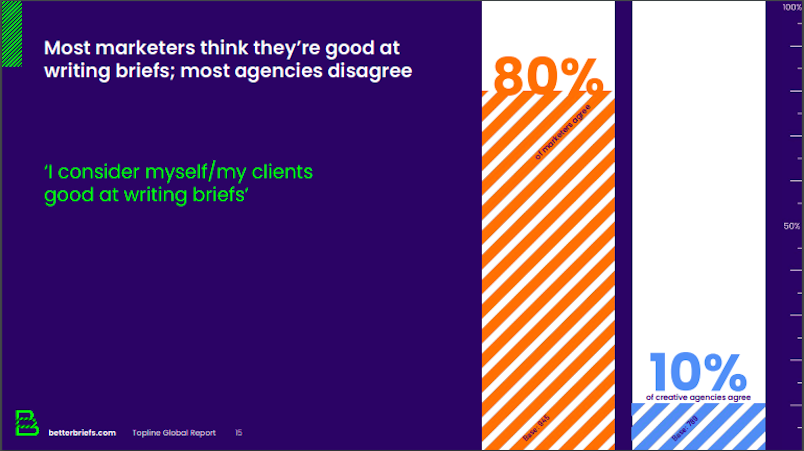
Brief encounters: Worse than feared
Pieter-Paul von Weiler and Matt Davies had a session in the pub lamenting the state of advertising briefs. When they woke up, the strategists decided to channel their fury – and found the problem is far worse than even they thought.
Months of deep research later, spanning 1,700 marketer and agency respondents across 70 global markets including Australia, the UK, the US and Europe, they found bad briefs are wasting a third of marketing budgets. That equates to $5 billion-plus of ad spend being lost annually in Australia and north of $200bn globally.
They found that while some top marketers admit to being “embarrassed” about the “briefs by committee” they are handing to agencies, those CMOs are in the minority. Most marketers think their briefs are good. Agencies, however, strongly disagree – and the problem is getting worse.
Prof Mark Ritson puts the research’s headline findings succinctly: “90 per cent of marketers fail to brief agencies effectively, and their failures begin with a total lack of strategy.”
The professor never knowingly minces his words. But the Better Briefs Project backs that statement to the hilt – and Ritson played a key role in amplifying the survey and helping to drive responses, according to von Weiler, in return for getting his hands on the results.
Better Briefs key findings:
- 80 per cent of marketers think they are good at writing briefs; only 10 per cent of agencies agree.
- Creative agencies think most marketing briefs lack focus (83 per cent), clarity (79 per cent) and inspiration (65 per cent).
- Most marketers (78 per cent) think the briefs they write provide clear strategic direction; only five per cent of agencies agree.
- Agencies said a lack of clear objectives and outcomes was the biggest problem, followed by a lack of clear strategy.
- Marketers and agencies are not even speaking the same language: 83 per cent of marketers think their briefs are written clearly and concisely. Only seven per cent of agencies agree.
- It’s not just language. Some 80 per cent of creative agencies feel marketers have a poor or limited understanding of what they need from briefs.
- 90 per cent of marketers admit that their briefs change once they are briefed-in.
- Worse, 6 out of 10 marketers admit to using the creative process to clarify the strategy. I.e. most marketers have failed to nail their strategy in the first place and want agencies to do it.
- As a result, an estimated 33 per cent of marketing budgets are wasted on poor briefs and misdirected work.
As von Weiler says, if the strategy is off, the brief is off, and everything that follows "goes to shit".
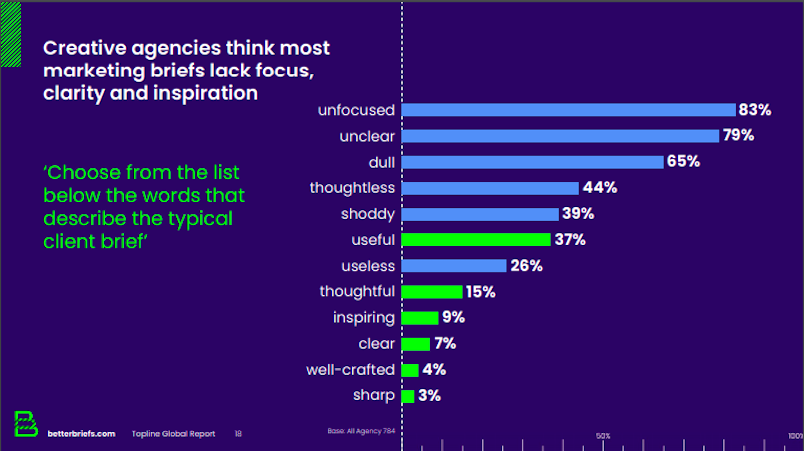
Strategic basics, respect the brief
Matt Davies offers an example of what led to the cathartic pub session and ultimately spawned the Better Briefs Project: a brief from a marketer at an ASX-listed company that contained a single sentence in a Microsoft Word document. “That was the extent of the brief for a company that is worth multiple millions of dollars,” says Davies.
Marketers, he says, should be setting marketing strategy, not asking their creative agency to set it for them.
“Yes, working with clients, we know intrinsically what their business is about,” says Davies. “But that doesn't mean that a brief from a marketing department to an agency should be given such little respect.”
Given their experiences, Davies and von Weiler had a hunch that the issue was common, if not widespread. But the only research they could find was conducted by the IPA – the UK’s Institute of Practitioners in Advertising – back in 2003. It was a sorry state of affairs back then. But the Better Briefs research suggests a continued negative spiral that is likely fuelling diminishing CMO tenures and a sense that the quality and effectiveness of brand advertising is in decline.
It all starts with the brief, and the brief can only be informed by clear strategy. Which means marketers need to come up with a strategy and clearly communicate it, not leave it to agencies to decipher – or even create. For their part, agencies must make sure that they have a clear brief, and if necessary, push back.
Ultimately, that calls for genuine partnerships and honest, two-way communication. Sounds simple. But according to the research, marketers and agencies globally are struggling with those fundamentals.
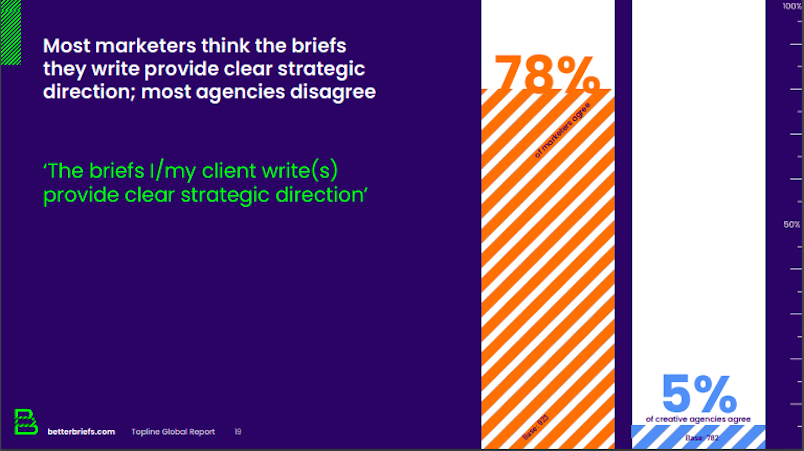
A failure to communicate; a master-slave relationship
Both marketers and agencies agree good briefs are key. But they are worlds apart on what ‘good’ briefs looks like: Some 80 per cent of marketers think they write good briefs. Only 10 per cent of agencies agree.
That disconnect is a major concern, says von Weiler. Drilling down on that question, however, he says one in three marketers admitted their last three briefs were not good enough, “and I think that is the most concerning [finding].”
But von Weiler says it’s incumbent on agencies to speak up. “Both parties are at fault here, agencies are not giving feedback: ‘Hey, this brief isn't working for me’. But also [it’s on] marketers knowing that the brief they are providing isn't good enough.”
Are marketers and agencies not talking to each other? Von Weiler thinks that is the crux of the problem, given the consistency of the data across geographies.
“You get the impression that there is a master-slave relationship instead of a partnership, which is what it should be. Ironically, both marketers and creative agencies are in the business of communication, but clearly, we're not very good at communicating about briefs.”
That 78 per cent of marketers think their brief contains clear strategic direction but only 5 per cent of agencies agree suggests something is being lost in translation, perhaps before that point, says von Weiler.
“It's either the agencies are not understanding, or the strategic direction isn't good enough, and it's probably a mix of the two. But the only reasons we write briefs is to direct creative thinking and to inspire it. So if a marketing brief doesn't direct, everything else goes to shit.”
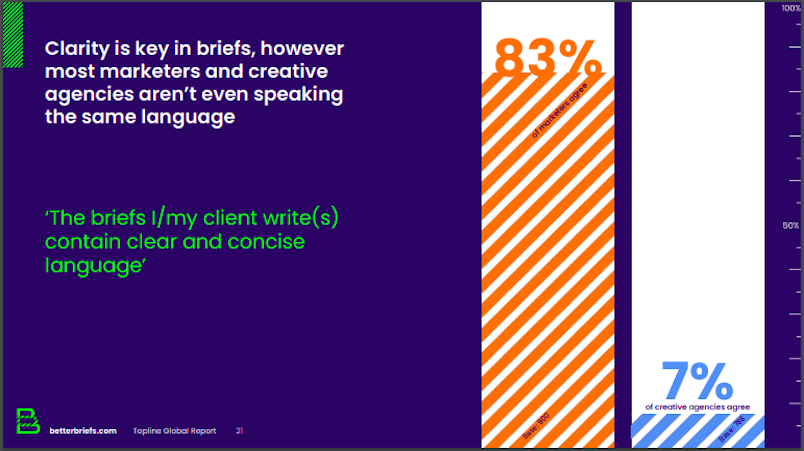
Nail strategy, speak business, not marketing
Even where strategic direction may be present, it’s too often obscured by marketing jargon: While more than 80 per cent of marketers think their briefs contain clear, concise language, only 7 per cent of agencies agree.
“There’s this weird marketing language, ‘marketingese’ that we all get carried away with,” says von Weiler. “We need to strip all of that out and make it really simple.”
But he says the issue of strategy and language is not necessarily entirely the marketer’s fault.
“I think in some situations, the entire business might have a poor strategy. So the CMO can’t translate that into a marketing strategy. In other instances, there's poor strategic marketing thinking. As a result of that, the brief becomes shit.”
Von Weiler urges marketers to read the IPA’s Board Brand Rift report, which outlines the disconnect between marketing and CFOs and CEOs, much of which is due to literally speaking different languages.
“We as a marketing industry don't speak the language of business enough,” says von Weiler.
“As strategists, we welcome business language into our briefs, because from a commercial perspective, we need to know what's going on. So let's not talk about brand halo effect; I want to hear about margin protection. Let's not talk about brand equity; I want to hear about investing in the reputation of a company and growing the trust of our customers. I don't want to hear about brand preference – maybe it's part of the mix – but I'd rather talk about risk reduction in the long term. There is something we can do collectively to speak the language of business more.”
Davies agrees – and says marketers need to understand what they mean when appropriating the latest buzzwords. If they do not, strategists will have little clue about what the brand wants to achieve.
“There’s a tendency toward generic terminology: My brand is ‘genuine’, ‘authentic’, ‘real’ – buzzwords and trends of the moment. What is actually behind that? How do we interpret authentic? How do we interpret genuine? How are these generic words allowing us to find something interesting when every brand is trying to garner trust or whatever it might be?” he says.
“So there are the business language issues that Pieter-Paul is flagging, but there is also [the issue of] generic language being used that is not differentiated amongst any brands.”
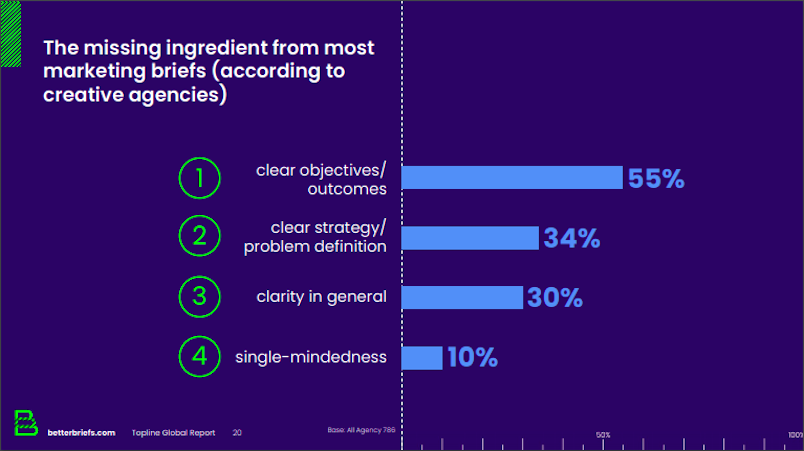
“Agencies are screaming for objectives”
Asked to rank the most important elements of a brief, objectives came top by mile.
“Agencies and marketers both ranked objectives at least three or four times more important than any other element of a marketing brief,” says Davies. “61 per cent of marketers ranked objectives first and 71 per cent of agencies. I know personally that’s the first thing I look at in a brief – and I'm not sure why it's not at the top of a briefing template.
“Usually you get some other fluff and crap that sits there. But if you can't connect objectives to the rest of the story, then you don't have a clear marketing brief. [But the data shows] that is what is being wanted by both parties to drive that clarity and strategic direction.”
Von Weiler agrees.
“Agencies are screaming for objectives. We just want to know what needs to shift in people's brain about the product or the brand you're selling that's going to drive a certain behaviour and that's going to drive a commercial goal … The worst briefs anecdotally contain only attitudinal objectives: ’Grow my awareness by 10 per cent’. Okay, what's the bigger picture here? What are you trying to achieve?”
Davies says a good brief should have both hard objectives – the outcomes the business wants, such as volume or value growth; and soft objectives – the attitude or behaviour shifts required to drive those business outcomes. He and von Weiler call these “linked” or “laddered” objectives, “rather than what we tend to see, which is a whole bunch of attitudinal statements that don’t have any correlation,” says Davies.
“Once you get that ladder right, then it's much clearer to see the path forward for creativity in helping to solve that problem.”
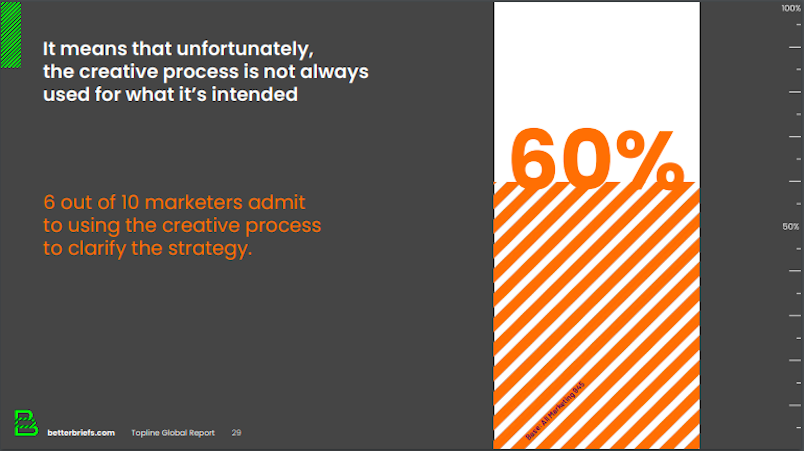
How is this even happening?
If marketers are failing to set clear objectives, how can they even benchmark results – and why are so many failing to do the basics?
Part of the problem, the report suggests, is too many corporate cooks throwing random ingredients into the pot.
As one UK marketer surveyed for Better Briefs admitted: “My briefs get re-written by committee – and those people are very senior but with no clue about marketing. My briefs get filled with jargon, nonsense and irrelevance, plus audiences, targets and topics are added in order to keep everyone feeling like their area of work is valid. I’m ashamed to send them over.”
Davies says that frank response highlights the pressure marketers face – and that the problems are not all their own making.
“They're not always producing the brief they want the agency to receive because there's a lot of stuff that they can't necessarily control. We were very surprised to see that come through in the survey as well, but it was also refreshing, because we don't want to give marketers a hard time – they've got a hard job managing all that stuff as well.”
The survey also asked ‘are the right people signing off on the briefs?’ Half of marketers admitted that the right people are not signing them off.
“So that's the first clue to why we're maybe not getting the right objectives,” says von Weiler.
Around the world, people think about one third of every budget goes to waste on poor briefs and misdirected work.
The $200bn bungle
In a global ad market now tracking north of $600bn, the Better Brief Project’s findings that a third of budgets are wasted due to bad briefs suggests a $200bn problem.
“We asked [survey respondents] to estimate how much of the marketing budget is wasted on poor briefs and misdirected work – and the result we got back was very consistent,” says von Weiler. “People around the world think that it's about one third of every budget goes to waste on poor briefs and misdirected work.”
According to Davies, the estimated wastage figure averaged 30 per cent for marketing respondents, and 37 per cent for agencies.
“The difference between those figures across the world – and between marketers and creative agencies – is narrow enough for us to say with some confidence that it’s an estimate worth taking note of, and that it's going to cause a big problem,” says Davies. “That’s what is worth having a conversation about.”
Von Weiler says the issue goes deeper than money – because there are negative knock-on effects.
“When you put a poor marketing brief into an agency, it will lead to quite shallow strategic thinking. It will lead to shallow and poor creative ideas that will be presented back to the marketers that aren't too happy, which will lead to an additional round of concepting and additional rounds of approvals. A lot of time and money is lost in all of these additional rounds, and ultimately it will affect staff's wellbeing, both on the marketing side and the creative agency. People will be less motivated to work on a project to work on the brand,” says von Weiler.
“Most importantly, the work that goes into the market won't be as effective as it could be.”
Data coming through suggests that within Australia, 50 per cent of marketers haven't been trained in writing briefs and the briefing process. That's half of marketers that operate in this country. So invest in your staff.
So what are the fixes?
In short, the report recommends three simple fixes for marketers and agencies:
- Invest more time in briefs.
- Work closer together on briefs.
- Ensure you’re speaking the same language.
There’s no template, says Davies. But it boils down to “how both parties engage with each other.”
One crucial remedy is to “get the right people to sign off the brief,” he says. “Another key stat was that almost three quarters of marketers suggested that their briefings with agencies could benefit from more structure. That seems like a really simple fix – put a good process and a good structure around the interactions that you have with your client and with your agency.”
Meanwhile, “data coming through suggests that within Australia, 50 per cent of marketers haven't been trained in writing briefs and the briefing process. That's half of marketers that operate in this country. So invest in your staff,” adds Davies.
“Then they won't feel like they're handing something to their agency that isn't well received and well respected. They'll feel more part of the process rather than using the creative process to clarify the strategy, which is part of the other problem that we're finding as well: Over 60 per cent of the time, the creative process is used to clarify the strategy. Let's stop doing that. Let's get the strategy right.”
I used to work at Saatchis in London. Diageo invited us over and we did two days training on how they were going to brief us ... and that made us understand at a much deeper level what they wanted from us. At the same time, we were able to push back in a constructive way.
What would Diageo do?
While the Better Briefs research quantifies the scale and impacts of bad briefs, there are always exceptions to the rule. From personal experience, von Weiler suggests Diageo is the gold standard.
“I used to work at Saatchis in London. Diageo invited us over and we did two days training on how they were going to brief us. We did exercises together, we were completely trained in how we were going to be briefed, and that made us understand at a much deeper level what they wanted from us,” says von Weiler.
“At the same time, we were able to push back on a brief in a really constructive way. ‘Hey, you trained me on this, but you are giving me that, what do you mean?’ So the conversation was much more productive after the actual brief.”
He says that is a key takeout from the Better Briefs Project for both marketers and agencies.
“Tomorrow, or next week, call your clients, call your agency. Sit down with each other and have a chat about how well the process is working at the moment. Does the agency feel that they can push back or not? If we can start that process happening, then we’re already happy.”
When it comes to briefs be curious, be empathetic, be persistent really early on in the process when it comes to asking those tricky questions. And if you think the brief is rubbish, challenge it. Because rubbish in rubbish out – we all know that.
Rubbish in, rubbish out: A top marketer’s view
Jo Royce, Chair of Judges, IPA Effectiveness Accreditation and Global Director Marketing Learning & Capabilities at Unilever, says the report underlines the key issues marketers and agencies face. She urges both sides to take note – and take action.
"Be empathetic and challenging of briefs – because behind every crappy brief is somebody who needs some help and somebody who might need greater gathering of insights," says Royce.
“A crappy brief if you are agency side is so frustrating – I know, I've been there – but it's also really frustrating if you are client-side sometimes. Particularly if you've got a 1,000 stakeholders who all have a slightly different perspective over what the problem is, let alone how you are going to solve it,” she adds.
“So when it comes to briefs be curious, be empathetic, be persistent really early on in the process when it comes to asking those tricky questions. And if you think the brief is rubbish, challenge it. Because rubbish in, rubbish out – we all know that.
“Challenging a brief – politely and respectfully – doesn't have to be personal or belittling or ‘out-clevering’. It just means that you are trying to get to the nub of the issue and the challenge you need to answer – because we all know that with a rubbish brief it's going to be really hard to prove results, and you're lucky if you get great outcomes.”
